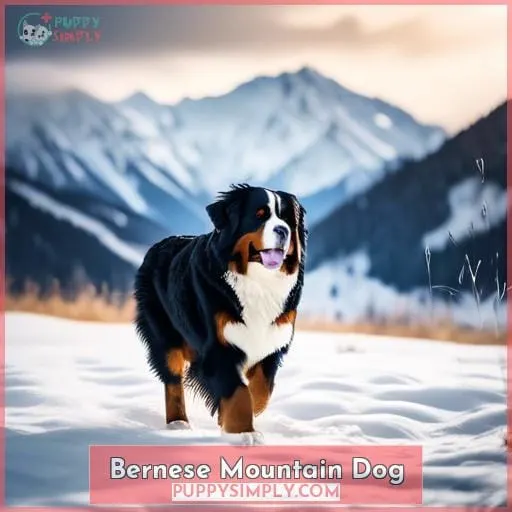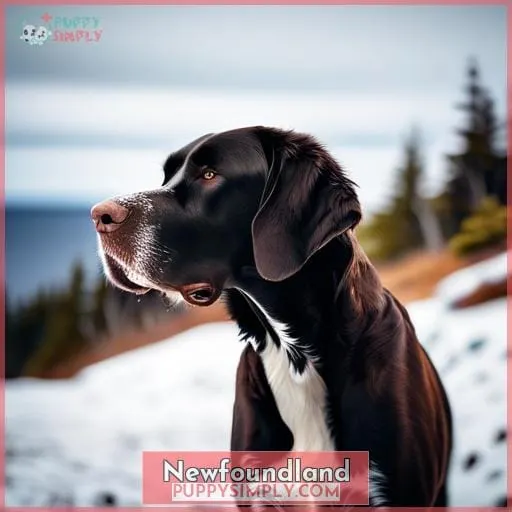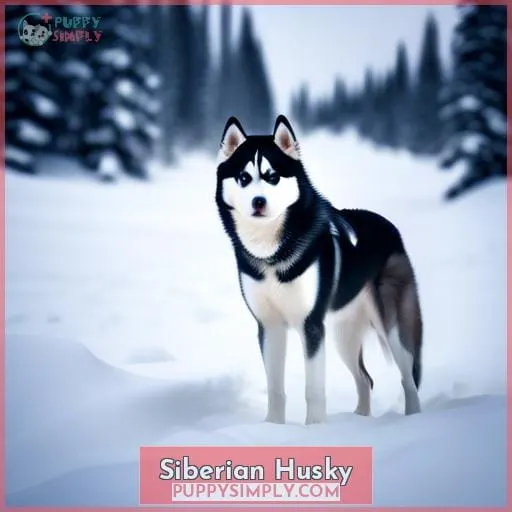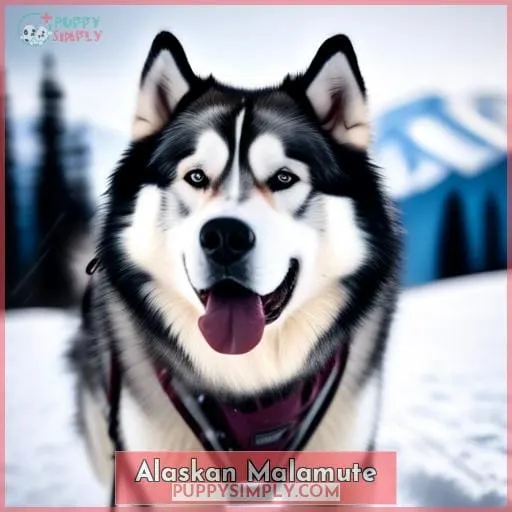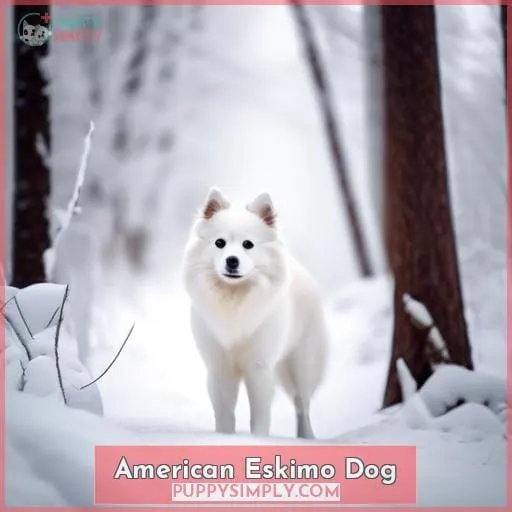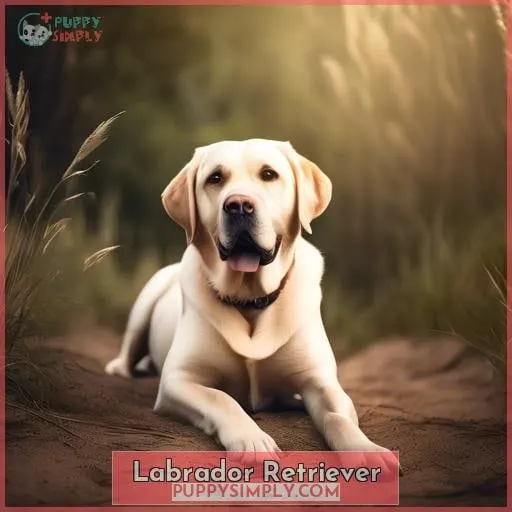This site is supported by our readers. We may earn a commission, at no cost to you, if you purchase through links.

surrounded by towering trees
and a sky full of stars.
You’re free to explore,
to roam,
and to connect with nature in a profound way.
Now, envision a pointer,
its keen nose sniffing the air,
its tail wagging with excitement.
Can this dog, bred for hunting and companionship,
adapt to the challenges and beauty of outdoor living?
In this article,
we’ll delve into the world of pointers
and their ability to thrive in nature’s embrace.
Table Of Contents
- Key Takeaways
- Bernese Mountain Dog
- German Shorthaired Pointer
- Beagle
- Newfoundland
- Chesapeake Bay Retriever
- Siberian Husky
- Alaskan Malamute
- American Eskimo Dog
- Labrador Retriever
- GSPs Living Conditions
- Frequently Asked Questions (FAQs)
- What are the best dog houses or shelters for pointers who live outside?
- How can I keep my pointer warm and dry during rainy or snowy weather?
- What kind of bedding should I use in my pointer’s outdoor kennel?
- What steps can I take to help my pointer adjust to spending time outdoors?
- Are pointers at higher risk for fleas, ticks or other parasites when living outside?
- Conclusion
Key Takeaways
- Pointers have less tolerance for frigid temperatures than breeds like Bernese Mountain Dogs.
- Special provisions like insulated, draft-free kennels and thermal jackets may help pointers handle colder weather.
- Pointers still require plenty of outdoor time and exercise even in winter.
- Providing warm bedding and easy indoor/outdoor access can help meet pointers’ needs in cold climates.
Bernese Mountain Dog
Bernese Mountain Dogs thrive in cold climates.
Their thick double coats protect them from frigid temperatures.
Picture them frolicking in the snow, their dark, tri-colored fur standing out against the white landscape.
These dogs aren’t just cold-tolerant; they relish it, becoming even more playful and energetic when the mercury drops.
While they may need a little extra food to fuel their winter adventures, their reluctance to come inside when it’s snowing is a testament to their love for the cold.
With their thick coats and unwavering love for winter, Bernese Mountain Dogs embody the spirit of outdoor living.
German Shorthaired Pointer
Unlike the Bernese Mountain Dog, the German Shorthaired Pointer, with its sleek coat, is less suited for frigid temperatures.
Yet, with proper care, it can thrive outdoors.
Ensure its kennel is weatherproof, insulated, and draft-free.
Install a doggy door for easy access.
In winter, provide a warm, elevated bed with ample bedding.
Consider a thermal jacket for outdoor activities.
Monitor your pointer for signs of hypothermia, especially puppies and seniors.
With love, care, and attention, your German Shorthaired Pointer can enjoy the great outdoors, even in winter’s chill.
Beagle
Venturing outdoors, Beagles are energized companions that revel in the fresh air and natural exploration.
Their compact, muscular build and dense coats make them well-suited for outdoor adventures, even in cold weather.
As a bird dog breed, Beagles possess a keen sense of smell and tracking abilities, making them excellent partners for hunting enthusiasts.
| Trait | Description | Impact on Outdoor Living |
|---|---|---|
| Energetic Playmates | Beagles love to run, jump, and play. | Require ample outdoor space and regular exercise. |
| Winter Adaptations | Their coats thicken in cold weather, providing insulation. | Can tolerate cold temperatures, but may need extra shelter in extreme conditions. |
| Tail Wagging | Their tails wag incessantly, even in the snow. | Contagious enthusiasm that brightens outdoor adventures. |
| Family Dogs | Beagles are loyal, friendly, and intelligent. | Thrive in family environments and make great companions for children. |
| Outdoor Activities | Beagles enjoy hiking, swimming, and exploring new scents. | Ideal for active families who love spending time outdoors. |
Newfoundland
As a Newfoundland owner, you’ll embrace winter’s icy grip with your dog’s enduring spirit.
This gentle giant, bred in Newfoundland’s frigid climes, thrives in cold weather.
Picture your Newfoundland relishing outdoor adventures, charging through snowbanks with boundless energy.
Their thick coat and innate endurance make them impervious to the cold, allowing for hours of outdoor play.
You’ll marvel at their unwavering enthusiasm, even as snowflakes dance around them.
Their love for cold-weather escapades is contagious, turning winter into a season of pure joy.
Chesapeake Bay Retriever
Chesapeake Bay Retrievers don’t mind cold winter weather.
Their bloodline of weather-hardy waterfowl retrievers makes them unconcerned about frigid temperatures.
Watch them take on cold-weather adventures and prance through snowbanks with glee.
These rugged retrievers thrive on outdoor exercise, rain or shine.
After a romp in the snow, they’ll happily cuddle up on the sofa, content to be in the warmth of your home.
Their adaptable nature makes them suitable for outdoor living conditions.
But remember, they’re playful dogs who love human company.
Siberian Husky
With their double-layered coat, Siberian Huskies are made for life in the outdoors. They thrive in cold weather and can withstand temperatures as low as -60 degrees Fahrenheit.
They’re natural athletes and require plenty of exercise, making them ideal for active families who enjoy spending time outdoors.
Their thick coat requires regular grooming to prevent mats and tangles.
Huskies are intelligent and independent, but they can also be stubborn and challenging to train.
If you’re considering adding a Siberian Husky to your family, be prepared to provide them with plenty of love, attention, and exercise. These dogs aren’t suited for apartment living or for families who are rarely home.
Alaskan Malamute
Like the Siberian Husky, you’ll find the Alaskan Malamute is another hardy breed well adapted to outdoor living in cold climates.
Their thick double coat and dense undercoat provide excellent insulation, allowing them to thrive in even the harshest conditions.
They’re also natural athletes, requiring plenty of exercise, which outdoor living provides in abundance.
But remember, these dogs are pack animals and crave human companionship.
Ensure regular interaction and mental stimulation to keep your Malamute happy and healthy.
American Eskimo Dog
Your American Eskimo Dog will appear fox-like and agile, with a thick, double coat that shields it from harsh elements.
While they can adapt to outdoor living, their preference lies indoors, by your side. They thrive on human interaction and may feel isolated if left alone for extended periods.
While they can withstand cold temperatures, they’re not built for extreme conditions. Providing them with a warm, draft-free kennel is crucial, along with regular exercise to keep them stimulated and healthy.
Labrador Retriever
Labrador Retrievers make loyal and energetic companions that thrive in active households.
They have origins as water retrieval dogs that make them naturals for outdoor training, whatever the weather.
Labrador Retrievers develop thick double coats and webbed paws to help them swim and run through snow, mud, rain, or shine.
Their high energy and exercise needs mean they relish any chance to be outdoors working and playing.
A well-socialized Lab will happily keep up on hikes, frolic in puddles, or carry sticks for hours.
With proper conditioning, Labrador Retrievers adapt well to almost any climate.
Just be sure to give them the stimulation and togetherness they crave.
Labs want nothing more than to be by your side sharing adventures.
GSPs Living Conditions
You can’t just leave your GSP outside all the time. They prefer to be indoors with their people, even though they may be able to adapt to milder outdoor temperatures.
Due to their short coat, GSPs are prone to hypothermia when temperatures dip below 45°F.
Make sure yours has a cozy, insulated space when it’s cold out. Give them a coat for extra warmth and don’t leave them exposed to winter elements for long.
With proper care, your pointer can stay healthy and happy even when it’s chilly.
The right dog coat provides needed insulation without restricting movement. Choosing the proper size and material prevents outdoor neglect.
Frequently Asked Questions (FAQs)
What are the best dog houses or shelters for pointers who live outside?
While pointers are active dogs that enjoy outdoor time, they aren’t well-suited for full-time outdoor living.
Consider bringing your pointer inside and providing a dog house or insulated shelter outside for short supervised stints.
Meeting their needs for companionship and protecting them from the elements should be your top priorities.
How can I keep my pointer warm and dry during rainy or snowy weather?
Reader, ensure your pointer stays warm and dry this rainy season.
- Wear a cozy sweater.
- Use a waterproof doghouse.
Regularly check for dampness.
- Provide extra bedding.
- Limit time outdoors during downpours.
A bit of creativity and care will keep your energetic companion comfortable.
What kind of bedding should I use in my pointer’s outdoor kennel?
Provide your pointer with a thick, insulating bed made of straw or cedar shavings.
Ensure the kennel floor is raised off the ground and the bedding stays dry.
Regularly change out soiled bedding to help regulate body temperature.
Investing in proper bedding keeps your pointer comfortable outdoors.
What steps can I take to help my pointer adjust to spending time outdoors?
Make sure your pointer has shelter from wind, rain, and snow.
Get a cozy doghouse with warm bedding.
Slowly increase time spent outdoors as they adjust.
Provide interactive toys to prevent boredom.
Don’t leave them alone for long periods.
Check often and bring them inside before they get too cold.
Reward calm behavior outdoors.
Are pointers at higher risk for fleas, ticks or other parasites when living outside?
Yes, you’re right to worry.
Pointers spending time outdoors face increased exposure to parasites like fleas and ticks.
Be vigilant about preventative care like monthly flea/tick medication.
Check your pup thoroughly after time outside.
With proper precautions, pointers can safely enjoy the outdoors while avoiding pesky parasites.
Conclusion
You’ve experienced the call of the wild.
Now, it’s time to answer.
With patience and proper training, even pointer breeds bred for indoor companionship can adapt to outdoor living.
The key is tapping into their natural instincts while providing structure and security.
If you take it slow and steady, your pointer will thrive surrounded by nature’s majesty.
The wilderness awaits – trust your dog’s ability to embrace it, and discover true freedom together.

